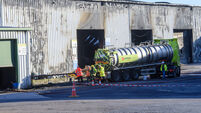Supervising building standards: Consumers left without protection

It’s just over two years since 72 people died in a fire in London’s Grenfell Tower. Had that building been properly fireproofed most of those, if not all, lives might have been saved.
We have not had a comparable tragedy, but a growing litany of reports concluding that a great number of Celtic Tiger era houses or apartments are not properly protected against fire, suggests that we are far more vulnerable than is acceptable. Once again, poor, box-ticking regulation and remote supervision have failed those it is in place to protect.
















